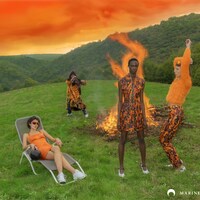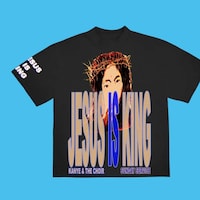From celebrity runway cameos, to behemoth collaborations and the concept of a couture ‘shop’, this year saw the introduction of Kardashian Kouture
In the beginning, there was denim. Woven in Japan, buttoned in sterling silver and lined in silk, a pair of wide-legged jeans passed through a Disneyland redux of Cristóbal Balenciaga’s former couture salon: all stencilled-on doorways and gilt chairs pushed up against limewashed walls. It had been almost 50 years since Balenciaga had last shown a couture collection, but a modest audience of fashion editors and brand ambassadors hushed to devour the details when a comeback was staged last summer. There were floor-sweeping opera stoles and zip-up hoodies, spectral wedding dresses and stiff tracksuits, taffeta ball gowns and fuzzy bathrobes. It didn’t always look like haute couture, but it was – expensive, artisanal, unusual.
If the maison’s made-to-order operation shuttered in 1968 on account of there being “no one left to dress”, then Demna’s debut questioned what constitutes an haute couture garment to begin with – repackaging mundane and quotidian clothing as objects of elite consumption. “For couture to be modern, it has to be a wardrobe,” he said at the time. “We cannot get locked into the ballroom.” And yet, those words could just as feasibly describe the past decade in mainstream fashion, which has seen casual items repositioned as premium goods under movements like normcore, athleisure, and streetwear. Only now, the same thing seems to be happening with couture. Just as Balenciaga bores into the aesthetics of “regular” people, this year, the sector as a whole began to court mass attention – as if it could ever democratise something that will only ever be experienced by the one percent.
Much of this has been at the hands of Demna, who’s spent the last 12 months marketing haute couture in the same way he would with ready-to-wear. He opened a store where customers could buy made-to-order, off-the-rack, cast Dua Lipa, Nicole Kidman, and Kim Kardashian as salon models, and even played a bit part in The Kardashians to document those fittings. Olivier Rousteing also featured in that episode, inviting cameras behind the scenes of his Jean Paul Gaultier collaboration (which is itself more of a streetwear thing) before parading models onto an open air balcony so that Parisian locals could ogle at the collection, too. It was symbolic, then, that John Galliano’s AW22 couture collection at Maison Margiela should take the form of a live action film – shot in real time and streamed simultaneously to a digital audience, it embodied high culture’s parlay into popular entertainment.
Whether people like Demna are effective in subverting the values of the bourgeoisie – while continuing to sell couture for upwards of £40,000 – is an ambient tension. Because why should the hinterland of dressmaking even attempt to adopt a mainstream veneer? The Chambre Syndicale upholds strict regulations around the production of haute couture in order to avoid this kind of dilution. There are only 16 houses in total and each one must maintain a Parisian workroom with a minimum of 20 employees producing at least 25 outfits per season. This, the organisation argues, is an attempt at keeping the practice alive and maintaining distance. But it also keys into the unique moral panic that so often collects around the “popularisation” of high art – that which threatens cultural hegemonies, reducing treasured artforms into something that feels artificial and somehow insincere.
The prestige connected to couture comes from it being reserved to a certain number of people, and its esteem is jeopardised when that’s communicated to a mass audience. It requires less knowledge, less sophistication to decode a couture garment’s perceived worth when it’s showcased on the back of an A-lister. These kinds of anxieties surrounding status ambiguity have surfaced across other talking points, too. The cultural fascination with nepo babies, TikTok influencers at fashion week, and a renewed interest in Forbes’ billionaire list are all a direct result of a social hierarchy where everything feels a little muddled. So could the popularisation of haute couture also reflect a return to order, a reinforcing of distance after fashion’s obsession with authenticity marketing and its myth of meritocracy? Perhaps that’s also why the audience at Dior’s couture show was reduced from 800 seats to 270 last season.
“Celebrities on the runway… at a couture show…?,” one member of High Fashion Twitter tweeted earlier this summer along with a screenshot of Miranda Priestley scowling – which is to say: online, the distinctions between ready-to-wear shows and couture shows are dissolving even further. If both operations can be staged in far-flung locations, feature major celebrity cameos, and be livestreamed across the web, then 2022’s lean into Kardashian Kouture has forged a monoculture of scaled-up, blockbuster runways. Of course, this is all well and good providing the spectacle doesn’t come at the expense of craftsmanship. Attendees at the autumn couture shows noted the presence of visible safety pins and sellotape – which is perhaps more to do with the timeframe afforded to each collection than the skill of the artisans working on them – but it begs the question: if couture is not the accumulation of decades of excellence, precision, and technique, then what purpose does it serve?
Couture is often referred to as a “fashion laboratory” but it’s also a marketing machine – it’s been that way since the 1980s when Bernard Arnault of LVMH transformed the cloistered salons of Paris into multi-million-pound pageants to promote perfumes, cosmetics and small leather goods. Even despite the fantastical work of Glenn Martens, Daniel Roseberry and Iris Van Herpen, haute couture makes virtually zero profit, which is a fact compounded by its dwindling client base. There were nearly 200,000 couture clients in the 1950s compared to approximately 4,000 today (which isn’t altogether surprising considering people have less reason to wear ball gowns) but it seems a lower level of connoisseurship has moved couture into a new, hype-driven direction. Hence all the celebrities, the shops, the collaborations – things that once seemed antithetical to its cherishing of the highbrow.
If the runway is now considered a pop cultural arena (much like music videos, red carpets and film) then it makes sense that couture – fashion’s most magnificent component – should become its epicentre. And if there’s little to no profit to be gleaned from the institution, then why not harness its power as a genre of entertainment? Even if very few people can actively participate in its spoils, there’s clearly a cultural appetite for conspicuous glamour and theatrics – see all the nostalgia attached to Victoria’s Secret and 90s fashion shows, for example. Today, couture can mean craft, but it can also mean content. “People are increasingly aware that [couture] is the top in terms of fashion creation,” Sidney Toledano, the head of the Chambre Syndicale said. “That's not only creating a buzz; it’s a strong act of creation.”
This isn’t an altogether bad thing. If anything, designers are testing the limits of what haute couture can, or should, mean today. It isn’t a death, but a rebirth. Nor is it a democratisation – couture is supposed to be “for the happy few” as Bruno Pavlovsky, the president of fashion at Chanel, calls them – but it is a popularisation. And for all those that rankle at the prospect of a couture tracksuit worn by an influencer, it’s worth remembering that Mona von Bismarck (an American socialite) once had Cristóbal Balenciaga himself make her bespoke gardening clothes.




